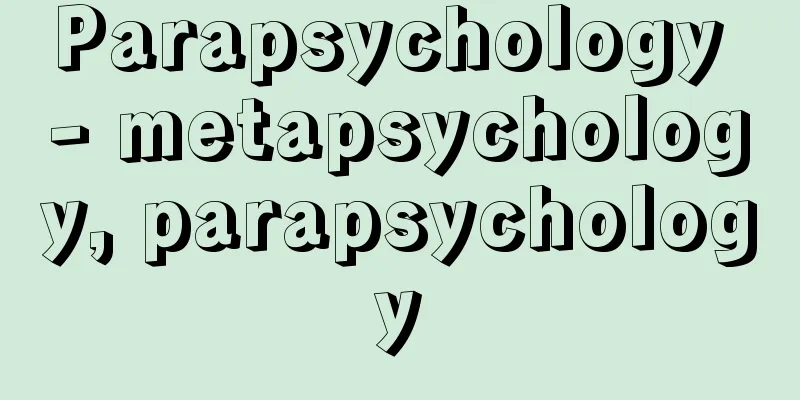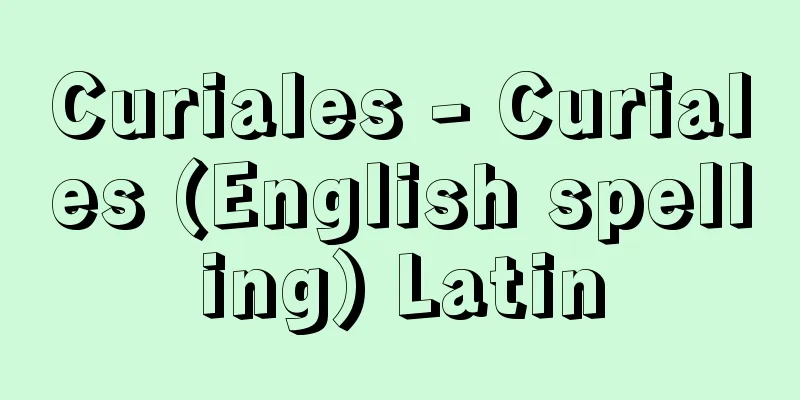Parapsychology - metapsychology, parapsychology

|
It refers to an area that goes beyond the scope of research in conventional psychology, and is primarily used in the following two senses. 1. A term coined by Freud, S. in his book Das Unbewusste (On the Unconscious) (1915) to name the system of psychology he created. In this case, it corresponds to metapsychology and is also called metapsychology. At the time, the orthodox field of psychology was experimental psychology based on consciousnessism, and its main goal was to clarify and quantify the elements of consciousness. However, Freud coined this term because his own system described psychological processes in terms of dynamic, local, and economic relationships, and went beyond the realm of orthodoxy. It is sometimes translated as superconscious psychology. In modern terms, the analysis and measurement of consciousness are contrasted with areas such as needs and motivation, the relationship between consciousness and the unconscious, the structure of personality, the mechanism of mental conflict, and the pathology of neurosis, and the academic scope of psychoanalysis is much broader. 2. J.B. Rhine classified the subjects of traditional psychical research into psi phenomena, and this term refers to experimental psychological research into them. In this case, it corresponds to parapsychology, but metapsychology can also be used. In the Western world, mesmerism (animal magnetism) developed into hypnotism in the 18th century, and the appearance of mediums who showed special abilities such as recollecting past lives and communicating with the dead when in a trance state was prevalent. This led to an increase in interest in psychic phenomena, and séances were frequently held. Mediums were also said to be able to directly sense distant or future events, transmit thoughts by telepathy to read the minds of others, pass through objects, and perform telepathy (projecting letters or images onto photographic plates using telekinesis). The Society for Psychical Research was established in England in 1882 and in the United States in 1885, and famous scholars such as James, W., McDougall, W., and Bergson, H. participated in it. In Japan, at the end of the Meiji period, Fukurai Tomokichi, an assistant professor in the psychology department at the University of Tokyo, made public his telepathy experiments, and physicist Tanakadate Aikatsu also attended, but Fukurai was expelled from the University of Tokyo in 1913 due to suspicion of manipulation. Line classified psychic phenomena into two categories: extrasensory perception (ESP) and psychokinesis, and further divided the former into three categories: clairvoyance, which is the perception of objects and events without relying on sensory pathways; telepathy, which is the direct recognition of the mental contents of others; and precognition, which is knowledge of future events. In order to rigorously verify these, he made various improvements to psychic research techniques. For example, he adopted ESP cards (Zener cards) with stars, waves, squares, circles, and crosses on them, as the traditional playing card guessing method was prone to bias based on personal preference. At first, Line's research methods were met with strong doubts and criticism, but after successive improvements, by the 1950s, it is said that more and more people were accepting the procedural validity of parapsychological experiments. Research in the Rhein School has uncovered the existence of people with special abilities who show a high success rate, that belief in psychic powers increases the success rate, and that ESP people have unique personality characteristics. Improvements to the method continued, and an ESP experiment was conducted using four types of cards under conditions where visual and auditory stimuli were made homogeneous and blank (Ganzfeld method), which showed an average success rate of 38%. This is a statistically extremely rare probability, and its significance cannot be doubted. However, if we subtract the chance hit rate of 25%, the absolute hit rate is extremely low, at only 13%. It is far from the perfect precognition or inspiration that common sense expects. Some well-known scholars, such as Eysenck, HJ, and Jung, CG, have a positive view of psychic phenomena, but the reality is that most psychologists are skeptical. For this field to truly develop, it is essential to construct a new psychological theoretical system that can rationally demonstrate the mechanism of psychic phenomena. →Consciousness →Hypnosis →History of Psychology →Psychoanalysis [FUJINAGA Tamotsu] Latest Sources Psychology Encyclopedia Latest Psychology Encyclopedia About Information |
|
通常の心理学の研究範囲を超える領域を指し,主に次の二つの意味で使われる。 1.フロイトFreud,S.が自著『無意識についてDas Unbewusste』(1915)の中で自らの創始した心理学体系に名づけた造語。この場合,metapsychologyに対応し,メタ心理学ともいう。当時の心理学の正統は意識主義に基づく実験心理学にあり,意識の要素解明とその定量化を主な目標としていたのに対して,フロイトは自己の体系は心理的過程を力動的・局所的および経済的関係によって記述するものであり,正統派の領域を超えるとしてこの名を唱えた。超意識心理学と訳されることもある。現代の用語におきなおせば,意識の分析と感覚測定に対して,要求と動機づけ,意識・無意識の関連,パーソナリティの構造,心的葛藤の機制,神経症の病理などの諸領域が対比されていて,精神分析の学問的範囲ははるかに広いといえる。 2.ラインRhine,J.B.は,旧来の心霊研究psychical researchの対象を整理してサイpsi現象とよんだが,その実験心理学的研究を指す名称。この場合,parapsychologyに対応するが,metapsychologyを充てることもある。 西欧社会では,18世紀にメスメリズム(動物磁気)が催眠術へと発展し,トランス状態に入った時に前世の想起や死者との交流など特異能力を示す霊媒の出現が唱えられ,心霊現象への関心が高まり交霊会がしきりに行なわれた。霊媒はまた,遠方や未来の出来事を直接感知する透視,他者の心を読み取る思念伝達,物体通過,念写(写真乾板に念力で文字や画像を映すこと)などが可能とされた。1882年イギリスに,1885年にはアメリカでも心霊研究協会が設立され,ジェームズJames,W.,マクドゥガルMcDougall,W.,ベルグソンBergson,H.など著名な学者が参加している。日本でも,明治期末に東大心理学科助教授だった福来友吉が念写実験を公開し物理学者田中館愛橘なども列席したが,作為の疑いで福来は1913年東大を追われる事件が起こっている。 ラインはサイ現象を,超感覚的知覚extrasensory perception(ESP)と念力psychokinesisの二つに整理し,前者をさらに,物体や事象を感覚径路によらず知覚する透視clairvoyance,他者の心的内容を直接認知するテレパシーtelepathy,未来の事態を知る予知precognitionの三つに分け,これらを厳密に検証するため心霊研究技法にさまざまな改良を行なった。従来のトランプカード当ては好みによる偏りが入るとして,星,波形,四角,円,十字を描いたESPカード(ゼナーカード)を採用したなどが一例である。初めラインの研究手法には疑問と批判が激しかったが,相次ぐ改善により1950年代には,むしろ超心理学実験の手続上の妥当性を承認する意見が多くなったといわれる。 ライン学派の研究は,高い的中率を示す特異能力者の存在,超能力への信念が的中率を高める,ESP能力者は独自のパーソナリティ特性をもつ,などの知見を見いだした。手法の改良は続き,視覚聴覚的刺激を等質空白化する条件下で4種カードのESP実験が行なわれ(ガンツフェルト法Ganzfeld method),平均38%の的中率が示された。これは統計的にはきわめて希少な確率であり,有意性は疑えない。しかし,偶然的中率25%を差し引くと13%にすぎず絶対的中率はきわめて低い。常識の期待する完全予知や霊感には程遠いといえる。著名な学者にもアイゼンクEysenck,H.J.,ユングJung,C.G.など肯定的見解を示す人もあるが,多くの心理学者は懐疑的というのが実情であろう。この分野が真に発展するためには,サイ現象の機制を合理的に論証できる新しい心理学的理論体系の構築が不可欠である。 →意識 →催眠 →心理学史 →精神分析 〔藤永 保〕 出典 最新 心理学事典最新 心理学事典について 情報 |
>>: Cheng-xin-tang-zhi; Chêng-sin-t`ang-chih
Recommend
Gotai Shinbunkan - Gotai Shinbunkan
A comparative dictionary of the five languages o...
Fogg Art Museum
As a result, some of the world's finest colle...
External occipital protuberance
A protuberance located approximately in the center...
Xanthoma
Histopathologically, xanthomas are characterized ...
al-kimiya' (English spelling)
… [Origin of Alchemy] It is said that alchemy pre...
Lincoln (sheep) (English spelling)
…(3) British Lowland Breeds These are meat breeds...
Kougetsucho - Kougetsucho
A Tozan-ryu shakuhachi piece. Composer: Nakao Toza...
Iraq Oil Business [Company] - Iraq Oil Business
… (2) The form of nationalization varies signific...
Feuchtersleben, E.von (English spelling) FeuchterslebenEvon
In ancient Greece and Rome, epilepsy, called the ...
International business
Business activities that are carried out across bo...
Mongolia
◎Official name: Mongolia/Mongol Uls. ◎Area: 1,564,...
Ashmolean Museum
…During the English Revolution, it was a base for...
urban ecology
…The majority of people are now urban residents, ...
Ben Bella
1912‐ Leader of the Algerian nationalist movement ...
Stola (English spelling)
A long-legged garment made of linen or light wool ...









